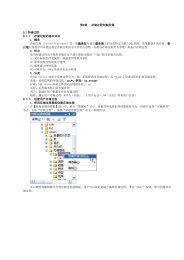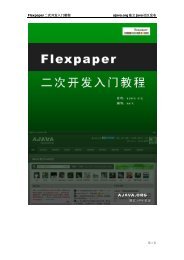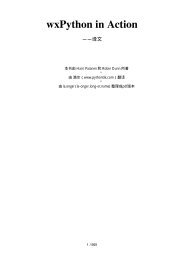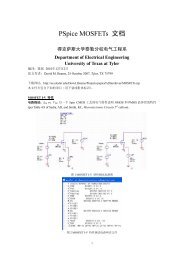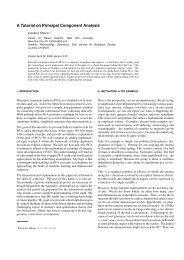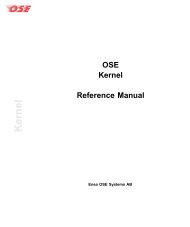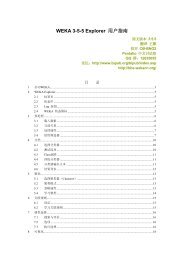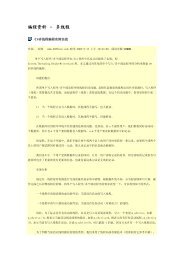Exception Handling ABI for the ARM Architecture
Exception Handling ABI for the ARM Architecture
Exception Handling ABI for the ARM Architecture
Create successful ePaper yourself
Turn your PDF publications into a flip-book with our unique Google optimized e-Paper software.
<strong>Exception</strong> handling <strong>ABI</strong> <strong>for</strong> <strong>the</strong> <strong>ARM</strong> architecture<br />
11001yyy Spare (yyy != 000, 001)<br />
11010nnn<br />
11xxxyyy Spare (xxx != 000, 001, 010)<br />
Pop VFP double-precision registers D[8]-D[8+nnn] saved (as if) by FSTMFDD (see<br />
remark d)<br />
It may be possible <strong>for</strong> application code to save registers in a variety of data representations. When restoring<br />
registers <strong>the</strong> personality routine will assume that <strong>the</strong> application saved <strong>the</strong> registers using <strong>the</strong> following<br />
representations:<br />
<br />
<br />
<br />
<br />
An integer register is assumed to be on <strong>the</strong> stack as if transferred by a STR instruction.<br />
A sequence of VFP registers encoded in a single unwind instruction are assumed to have been saved as if by<br />
FSTMFDX or FSTMFDD, depending on <strong>the</strong> unwind instruction used.<br />
A WMMX data register is assumed to have been saved as if by WSTRD.<br />
A WMMX control register is assumed to have been saved as if by WSTRW.<br />
9.4 Interpreting <strong>the</strong> tables<br />
Recall that <strong>the</strong> return address into <strong>the</strong> current function is in VRS[r15] on entry to <strong>the</strong> personality routine. The<br />
personality routines interpret an exception-handling table entry as follows:<br />
The descriptors are traversed linearly.<br />
Cleanup descriptors are ignored in phase 1. In phase 2, if <strong>the</strong> return address is within <strong>the</strong> specified range, <strong>the</strong> PR<br />
must update <strong>the</strong> virtual register set <strong>for</strong> entry to <strong>the</strong> landing pad, call __cxa_begin_cleanup (see §8.4), save<br />
whatever it needs in <strong>the</strong> UCB cleanup_cache (see 7.2) <strong>the</strong>n return _URC_INSTALL_CONTEXT.<br />
Catch descriptors are examined in phase 1. If <strong>the</strong> return address is within <strong>the</strong> specified range, <strong>the</strong> type of <strong>the</strong><br />
thrown exception is checked <strong>for</strong> a match against <strong>the</strong> catch type. __cxa_type_match (see §8.4) may be used when<br />
offset encodes a type_info object. A match denotes a propagation barrier and <strong>the</strong> PR should fill in <strong>the</strong><br />
barrier_cache and return _URC_HANDLER_FOUND. On re-encountering <strong>the</strong> barrier in phase 2, <strong>the</strong> PR should<br />
set <strong>the</strong> VRS <strong>for</strong> landing pad entry (passing <strong>the</strong> UCB address in r0) and return _URC_INSTALL_CONTEXT.<br />
Function exception specification descriptors are examined in phase 1. If <strong>the</strong> return address is within <strong>the</strong> specified<br />
range, <strong>the</strong> type of <strong>the</strong> thrown exception is checked <strong>for</strong> a match against <strong>the</strong> specified types. __cxa_type_match<br />
(see §8.4) may be used. No match against any of <strong>the</strong> types denotes a propagation barrier and <strong>the</strong> PR should fill in<br />
<strong>the</strong> barrier_cache and return _URC_HANDLER_FOUND. On re-encountering <strong>the</strong> barrier in phase 2, <strong>the</strong><br />
behaviour depends on whe<strong>the</strong>r <strong>the</strong> descriptor has an explicitly specified landing pad (signified by high bit set in <strong>the</strong><br />
type count word) or not:<br />
<br />
<br />
If it does, <strong>the</strong> PR should set <strong>the</strong> VRS <strong>for</strong> entry to that pad (passing <strong>the</strong> UCB address in r0), ensure <strong>the</strong> data<br />
required <strong>for</strong> __cxa_call_unexpected is in <strong>the</strong> barrier_cache (see §8.2), and <strong>the</strong>n return<br />
_URC_INSTALL_CONTEXT. The pad will call __cxa_call_unexpected.<br />
If it does not, <strong>the</strong> PR should execute <strong>the</strong> unwind description to virtually unwind <strong>the</strong> frame, set <strong>the</strong> VRS <strong>for</strong><br />
entry to __cxa_call_unexpected (see §8.4), ensure <strong>the</strong> data required <strong>for</strong> __cxa_call_unexpected is in <strong>the</strong><br />
barrier_cache (see §8.2), <strong>the</strong>n return _URC_INSTALL_CONTEXT.<br />
If <strong>the</strong> PR has retained control after processing <strong>the</strong> final descriptor, it must execute <strong>the</strong> unwind description to<br />
virtually unwind <strong>the</strong> frame. It must <strong>the</strong>n return _URC_CONTINUE_UNWIND, causing <strong>the</strong> unwinder to locate and<br />
initiate processing of <strong>the</strong> next frame.<br />
The PR is not allowed to change its mind about a barrier between phase 1 and phase 2.<br />
In summary, <strong>the</strong> <strong>ARM</strong> personality routines always pass a pointer to <strong>the</strong> UCB in r0 when entering a handler or a<br />
handler landing pad.<br />
<strong>ARM</strong> IHI 0038A Copyright © 2002-2005, 2007 <strong>ARM</strong> Limited. All rights reserved. Page 42 of 50



